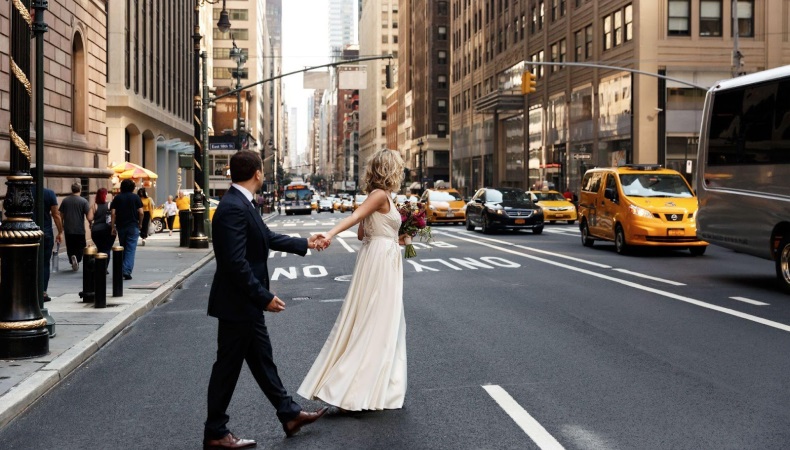For some people, Non-Traditional Wedding Ideas are a delight — but to others, they can feel like a straitjacket of conformity. If that’s how you feel, the good news is that hardly any wedding traditions are actually required! You’re free to replace, remix or even abandon them entirely as you see fit for your wedding.
That said, planning is still a must! Even the most non-conformist ceremony still needs a solid plan to make sure everything runs smoothly. If you’re considering a wedding that’s a little bit out of the ordinary, these tips will help you keep your big day on track, even when that track runs off the beaten path.
1. Decide what you do and don’t want
Start by thinking about the values you and your partner share, and which parts of your wedding are most important to you. Maybe you want to keep certain traditions but change up other ones, such as wearing a traditional white wedding dress but using black wedding rings. A wedding should be first and foremost a collaboration between you and your partner, so talk it over and find the middle ground that means the most to both of you.
2. Think beyond traditional venues
A non-traditional wedding opens up tons of options for venues. Nature lovers might choose a state or national park, or even a zoo or aquarium. Art aficionados might enjoy a gallery or museum, or a local cultural or historic site. Many of these venues will have an event sales team who make renting out the space an easy process and can connect you with local vendors like caterers and florists. If your wedding is small enough, you might even consider doing it in your (or someone else’s) back yard!

3. Consider your dress code
Tuxes and evening gowns certainly aren’t for everybody, so think about how you want your wedding’s dress code to reflect your desires and values. You might go for a casual dress code to maximize inclusion, or go dressy-casual to spruce things up a bit while keeping it classy. If you really want to get creative, you might include a suggested theme, like dressing in a certain color or from a certain era. Just remember that you’ll probably want to pick something that most of your guests will already have in their wardrobe, or can pick up without dropping big bucks.
4. Personalize your ceremony
The vows are one of the most meaningful parts of the ceremony for many people, so it’s definitely worth some extended reflection on what you want them to sound like. Many couples today write their own wedding vows, which can be a touching opportunity to express your deepest feelings when it matters most. Don’t feel like writing your own? Plenty of alternatives to the traditional vows are out there, so try out a few until you find some that you and your partner agree on.
5. Make sure your photographer understands what you’re going for
Your wedding photographs will be some of your most lasting and treasured memories of the big day, so make sure your photographer knows the right vibe to set. Communicate with them in advance about any themed elements you want in your photographs and the overall aesthetic that you want. One good trick is to poke around online for ceremony photos you like and then show them to the photographer for inspiration — the farther in advance, the better!
6. Find a wedding planner who gets your vision
A wedding planner is never required, but even the most offbeat weddings can benefit from a professional’s organizational skills. They can save you a ton of headaches when it comes to coordinating logistical challenges like sourcing vendors and keeping timelines moving. Look for a wedding planner with experience in non-traditional ceremonies, and schedule an initial consultation to get an idea of whether they’re excited about and capable of bringing your wedding dreams to life.
7. Get your legal situation in order
We noted earlier that most marriage traditions aren’t legally required — but there are a handful of legal boxes you’ll need to check for your marriage to be legally recognized (which has a lot of important benefits). Most importantly, you’ll need to apply for a marriage license from your local county clerk or a similar government entity, as well as the signature of an officiant in most states. Remember that you also have the option of a courthouse wedding in which you legally seal the deal at your county government building, leaving you plenty of options for celebrating later.

8. Consider eloping
Maybe you’re really not into the idea of a traditional wedding — period. In that case, you and your partner might think about eloping. Escaping to a beautiful place and saying “I do” has a long and rich history, and it can remove a lot of the external pressure from a moment that should be primarily about the two of you. Plus, you can use all that cash you’d be dropping on a wedding to make your elopement truly special, with plenty of options for exotic destinations and fun post-wedding activities (not to mention some extra bridal jewelry).
Every wedding has the potential to be as unique as the couple at its center. When you focus on what’s most important to the two of you, the magic will flow — so trust the person you love, and don’t be afraid to think outside the box!







